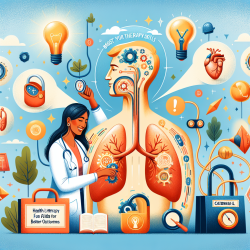Introduction
In the world of therapy and healthcare, understanding and applying health literacy can be a game-changer. Whether you're a seasoned therapist or just starting out, the ability to effectively communicate and educate your patients is crucial. A recent research article titled "A conceptual model of functional health literacy to improve chronic airway disease outcomes" provides valuable insights that can enhance your practice. Let's dive into the key takeaways and how you can apply them to improve patient outcomes.
Understanding the CADMaHL Model
The Chronic Airway Disease Management and Health Literacy (CADMaHL) model is a comprehensive framework designed to integrate various elements of disease management, health system factors, and socio-demographic factors. This model is particularly beneficial for patients with chronic airway diseases like asthma and COPD. It organizes health literacy into six primary modules:
- INPUT: Access, understand, communicate, evaluate, and numeracy skills.
- OUTPUT: Application of the obtained information.
- OUTCOME: Patient empowerment in performing self-management practices.
- ASSESSMENT: Information about the functionality and relevancy of CADMaHL.
- IMPACT: Mediators between health literacy and health outcomes.
- CROSSCUTTING FACTORS: Socio-demographics and health-system factors.
Applying the CADMaHL Model in Practice
As a therapist, you can use the CADMaHL model to enhance your communication and educational strategies with patients. Here are some practical steps:
- Enhance Communication: Use plain language and visual aids to ensure patients understand their health conditions and management plans.
- Empower Patients: Encourage patients to take charge of their health by providing them with the tools and knowledge they need to self-manage their conditions.
- Assess and Adapt: Regularly assess the effectiveness of your communication strategies and be open to adapting them based on patient feedback.
Encouraging Further Research
While the CADMaHL model provides a robust framework, continuous learning and adaptation are key. Encourage your colleagues and peers to explore further research in health literacy and its impact on patient outcomes. By staying informed, you can ensure that your practice remains at the forefront of patient-centered care.
Conclusion
Implementing the CADMaHL model in your practice can lead to improved patient outcomes and greater patient satisfaction. By focusing on health literacy, you empower your patients to better manage their health, ultimately leading to a healthier community. For those interested in delving deeper into the research, you can read the original research paper by following this link: A conceptual model of functional health literacy to improve chronic airway disease outcomes.










